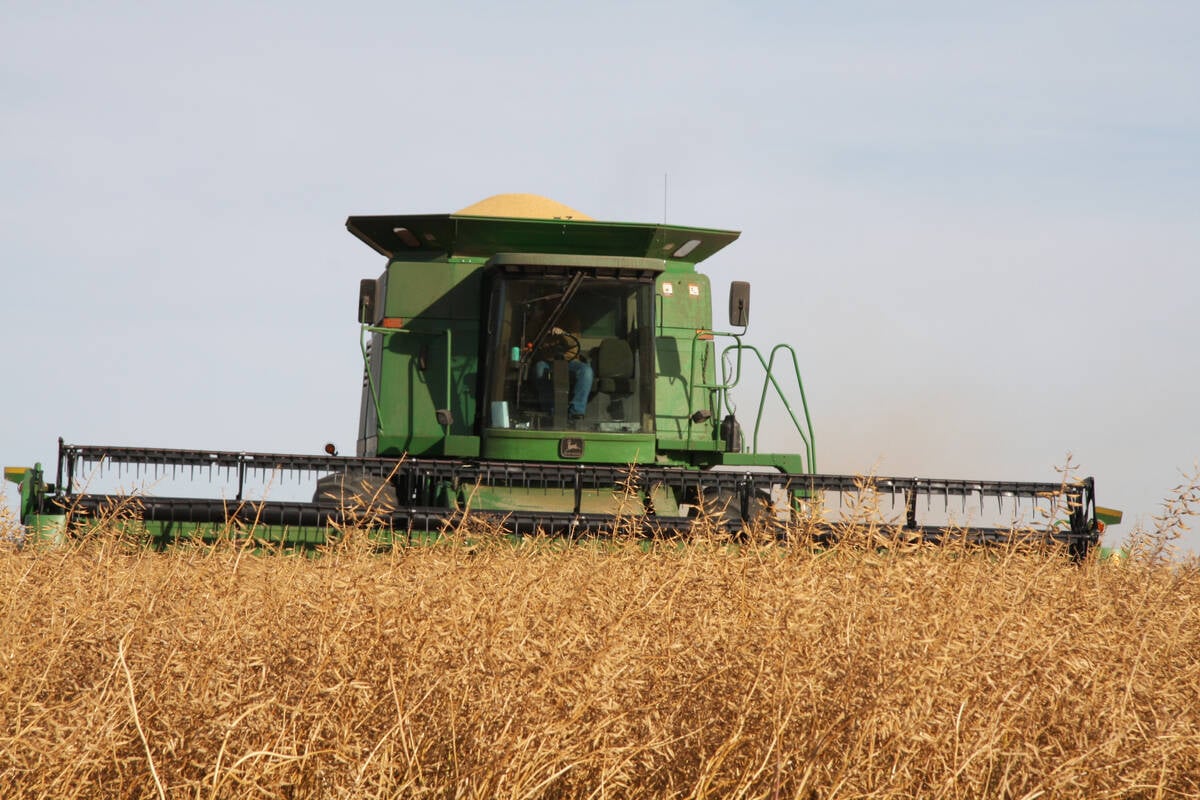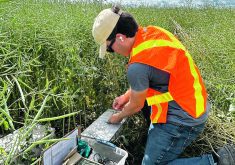Hybrid rye variety yields 100 bushels per acre in bad conditions and double that number in Saskatchewan test plots
With a proven potential of 200 bushels per acre in prairie conditions, treating hybrid rye the same as conventional open rye varieties or winter wheat will guarantee you a disappointing harvest.
“We’ve seen 200 bushels an acre in Western Canada. That was at Indian Head. It was just kissing 200 bushels in research plots,” says Ken Greer, owner of Western Ag Labs in Saskatoon. He adds that it’s an expensive crop to grow and there’s no room for cutting corners.
Lee Moats of Riceton, Sask., has been a grower of fall-seeded crops for decades, so it’s no surprise he tried Brasetto in 2015.
Read Also

Mustard processor expands in southern Alberta
$30 million expansion for southern Alberta mustard facility adds milling capacity to largest supplier in the world of value-added milled mustard products
Unfortunately, it was a year when weather messed up everybody’s trials in southern Saskatchewan.
Other stories in this WP Special Report:
The old Winter Wheat Production Manual is obsolete when it comes to achieving the high yield potential of the new hybrid rye varieties, says Moats.
“Bushels require nitrogen. You can’t grow 100 plus bushels of anything with the nitrogen you once put down to grow 70 bushels,” states Moats.
“There are similarities between the new hybrid rye and our other fall-seeded crops, but nitrogen requirement is a huge difference. What we’re trying to find out is how hard we can push these new crops to take full advantage of the genetic potential available to us. We know we’ve got to push them hard.
“Rye is more competitive with weeds than wheat, but we don’t want to risk an investment of $60 per acre in seed by letting weeds get out of control. You want to make sure you’ve taken care of your winter annuals.”
As for staging the nitrogen applications, keep in mind that the crop will wake up in early spring and it will be hungry. Moats says it’s best to put down some nitrogen in the fall just to make sure the plants have it come spring time. To hit those high yields, it’s important that the crop is never nitrogen deficient, not even for a day.
“So you want to get nitrogen on early in the spring, but do you put it all on at once in April or do you plan a split application? Right now, I don’t think we know enough about the crop to say for sure. My feeling is do it all at once.
“But that brings up the obvious question of what rate. Western Ag Labs is working on nutrient requirements of hybridized rye. They have a model and they have a particular philosophy about hybrids that’s appealing to me.
“Hybrid rye has a unique ability to extract nutrients from the soil and Western Ag factors that into any recommendation. The ability to scavenge nutrients is better than for wheat, so you need to account for it.”
Moats says he doesn’t have an exact number, but it could be that hybrid rye scavenges nitrogen from the soil 20 percent more efficiently compared to wheat. He explains that Western Ag’s nitrogen recommendations for hybrid rye are still based on assumptions for prairie conditions rather than actual prairie experience.
Here’s another question. If hybrid rye really is that much better at extracting nutrients from the soil, will it leave your field in a state of nutrient depletion the following year?
“We don’t have an answer to that either. We’re still learning how to manage these hybrids in Western Canada. I think the information we’re getting from Europe is important, but our conditions are different.
“We’re much colder in winter. In some of the areas where they grow rye in Europe, they barely even have frozen soil. We have hard frozen soil every winter and it’s for long periods of time.
“Cold tolerance must be considered. It looks like hybridized ryes have cold tolerance more similar to our winter wheat than to the fall rye we’ve typically grown here. So right now, we’re still just a little speculative as to exactly what we should be doing.”
When winter wheat growers inspect their crop in early spring, it often looks pretty scruffy. Rule of thumb says ignore it and go do something else so you don’t dwell on it and then do something foolish. If left alone, the crop usually revives itself and turns out to be pretty decent.
Moats says winter cereals in general are very resilient. They have a great ability to come back. He thinks the same applies to hybridized rye, but he’s not certain. As a crop update, he reports that the mild winter in the Riceton area was kind to his fall rye.
“The Brasetto and Bono crops on lentil stubble survived quite well. That’s very intriguing. If they can survive on lentil stubble every year, that opens up a whole new production potential. The rye is already green and growing (April 5) so that’s encouraging.”
Edgar Hammermeister farms in southeastern Saskatchewan and is an agrologist with Western Ag Labs. He is working with Moats and other producers to develop prairie-relevant nutrient recommendations for KWS hybrid rye varieties.
Moats owns a Green Seeker leaf monitoring system along with a good collection of algorithms, and has used it on most crops he grows. However, Hammermeister explains, the device is of no value in their quest for better nutrient management information because there are no algorithms for hybrid rye in Western Canada.
“Rye has a very aggressive rooting system. That includes conventional open pollinated varieties and hybrids. Relative to spring wheat, there’s a two X (two times) ability of rye to obtain nutrients from the soil,” says Hammermeister, explaining that winter crops always scavenge better than spring crops.
“Looking at our new generation of high output spring wheat, there’s a nitrogen supply rate of 24 pounds. That’s the amount of nitrogen the roots extract from the soil.
“For winter wheat it’s 34 pounds. CDC Ptarmigan soft white winter wheat is 41 pounds. And for hybrid fall rye, it’s such a new crop that we don’t have a finalized model, but it looks like 48 pounds of nitrogen supply scavenged from the soil.”
Hammermeister emphasizes the point that the new hybrid ryes can extract twice as much nitrogen from the soil compared to the best new generation spring wheat varieties. The advantage of any winter crop is they can do so much growing, first in the fall then in the April, May, June window when the moisture is almost always available. But if there’s a winter/spring drought, these crops really take a beating because they expect the moisture to be there for them.
“I’ve had that happen on my own farm. We had a bit of a dry fall. The winter wheat did get going, but then we had drought after the spring thaw. For fall-seeded crops, a drought in the spring is the same as a summer drought for spring seeded crops. But it doesn’t usually happen.
“For this growing season, I think there’s enough moisture in the ground in Manitoba and Saskatchewan and most of Alberta. There may be some parts of Alberta where there’s a concern.
“To make sure those fall seeded crops get the start in life they need, you’ve got to make sure there’s enough phosphate and potassium, especially phosphate to help build the crown.”
Contrary to what many people have expressed about winter hardiness of the new hybrids, Hammermeister says the work they’ve done at Western Ag indicates they’re not as winter hardy as conventional open pollinated rye. Their winter hardiness is closer to that of winter wheat.
“Those old fall ryes, you could really abuse them. You could put them on summerfallow and they’d come through the winter just fine. That was some hard core genetics at play. The hybrid rye needs a lot more TLC. You need to seed into stubble and catch some snow cover.”
He says that come spring, you’ve got to get nitrogen on before all those other spring seeding tasks take over. A nitrogen release inhibitor is a good idea to protect the nitrogen for 10 to 14 days. But whether you put it all on at once or do a split, is a matter of logistics on each individual farm.
“With fall rye, you’re aiming for high yield. Protein is secondary. Guy Lafond did some work with the GreenSeeker and found split nitrogen can still influence yield in cereals up to the six leaf stage. Guy said nitrogen after the six leaf stage influences protein.
“The first issue is you don’t want to put on the extra nitrogen unless you’re pretty sure it’s going to rain. The second issue is equipment and manpower. Top dressing generally comes at a time when you’re still spraying.
“Winter crops set their tillers and their yield potential according to the fertility they sense in the soil. Later, if there are stress factors, that’s when they decide how many of those tillers they want to support and keep alive.”
Hammermeister reminds growers that millers hate ergot and hybrid rye is vulnerable to ergot. The longer flowering window opens up the ergot gate. The assumption that the earlier flowering period should beat the normal ergot season is wrong. Even with a tighter, shorter flowering stage, flowering happens at the exact same time as for many of the grasses. He says KWS plant breeders have tried to tighten up the flowering window to minimize the opportunity for ergot, but they still have a way to go.
How well the crop resists ergot depends to a great degree on how well it comes through winter, which is why snow cover, fall potassium and phosphate are critical. He says good fall fertility also helps the crop go through its growth stages uniformly and quickly.
Ken Greer, owner of Western Ag Labs, says there is a direct correlation between winter survival and ergot. Good winter survival results in lower ergot. He says that if the crop looks patchy and scruffy in the spring, the ergot load is going to be high.
“The crop won’t be suitable for high end buyers who require zero ergot. That means you won’t get the price you want. It’s best to plow it under and seed a spring crop to make good use of the fertility you’ve already put into that field.”
Greer says a crappy looking crop with high ergot potential is not likely to have good falling numbers. While higher falling numbers are a major sales point for hybrid rye, he adds that falling numbers do not create high protein.
“Falling numbers are higher in hybrids regardless of nitrogen or management. It’s in their genetics,” says Greer, adding that more nitrogen builds more yield if it’s on early, but hybrid rye grain actually has lower protein in most cases.”
“Distillers want low protein rye. High protein causes discolouring in the liquor and a lot of frothing. Distillers want a lot of starch and low protein. Some protein’s OK for cattle, but you really don’t want too much there either because it can cause bloating.
“Millers love hybrid rye because the falling numbers are so good, and again the protein doesn’t need to be high. The KWS ryes are bred in Germany where they want good quality for those dark rye breads. So really, you don’t need protein for any rye market, but you do need to get a balanced fertility package on early to capitalize on the yield potential.”
He says falling numbers in an open pollinated rye would typically be low if the crop got rain during harvest. The seeds start to sprout and when that happens, falling numbers fall dramatically, as happens with any cereal crop.
But going head to head, even in wet conditions, Greer says falling numbers of the KWS hybrids will always be better than population rye. It’s not as if the KWS varieties are rain-proof, but they genetically have better falling numbers regardless of conditions.
“We’ve built a crop forecaster simulation model for hybrid rye. If you handle it like cowboy rye, you’re going to be disappointed. You’re going to have an ergoty mess and it’ll be less profitable than if you’d seeded population rye.”
Greer explains that the yield potential is determined by water, so the key is to match nitrogen to water availability if possible. He recommends getting enough nitrogen on in the spring so you can stay away from split applications.
“Our number one rule with these hybrids is don’t plant them unless you have a market. Keep in mind it’s an expensive crop to grow. Seed is $60 per acre and you’ll need to spend a bunch on fertility. Make sure it pencils out before you decide because you’ll fill your bins so quickly.
“You’re going to bushel out, there’s no question. You could hit 200 bushels an acre. It’s possible. We’ve seen it on research plots.”


















